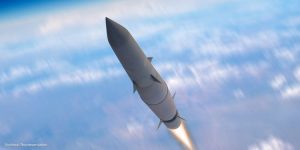On November 1, Japan’s Ministry of Defense announced that it has signed a contract worth 56 billion yen ($368 million) with Mitsubishi Heavy Industries to develop the Glide Phase Interceptor (GPI), a next-generation missile defense system, specifically designed to shoot down hypersonic missiles.
Japan and the United States are planning to complete development of the GPI by the 2030s. The project was first announced in August 2023 when then-Prime Minister Kishida Fumio and U.S. President Joe Biden held a summit meeting in Camp David outside Washington.
In September 2024, the U.S. Missile Defense Agency (MDA) and the Japanese Defense Ministry selected Northrop Grumman over Raytheon as the prime contractor for the project. The two U.S. companies had been vying for the development concept of the GPI.
With Northrop on the U.S. side and MHI on the Japanese side, the main GPI companies in both Japan and the United States have been now decided.
Northrop’s GPI concept has three features: 1) acceleration by a three-stage rocket motor, 2) destruction of the target by a kill vehicle in the warhead section, and 3) launch from an Aegis destroyer’s vertical launch system (VLS), according to the Defense Ministry.
“In the three-stage GPI, the first stage will perform the initial acceleration, and the second stage will fly towards the enemy. It will then be separated and the third stage will head in the final direction,” a defense official in Tokyo explained.
What is noteworthy is the division of development roles between the two nations. Each country will be responsible for its own area of expertise, based on its experience with the SM-3 Block 2A, which was also jointly developed by the two nations.

The breakdown of Japan-U.S. development sharing for the GPI. Image via the Japanese Defense Ministry.
Regarding the parts of the GPI that Japan is responsible for developing, defense officials in Tokyo said that they will mainly be in charge of the second-stage rocket motor and second-stage steering system, as well as the steering gear, rocket motor, and seeker window for the front part of the missile called the kill vehicle.
Meanwhile, the United States will be in charge of the first-stage booster, the third-stage rocket motor, the kill vehicle’s outer shell, guidance control device, and seeker. It will also be in charge of the overall system integration.
For the first-stage booster, the existing U.S.-made Mk 72 used in interceptor missiles such as the SM-3 Block 2A will be adopted.
In the case of the SM-3 Block 2A, its kill vehicle crashes into the target outside the atmosphere.
In contrast, the GPI is equipped with a steering device in the form of wings because the target, a hypersonic glide vehicle (HGV), is fast and has a lower gliding altitude than a ballistic missile. The GPI needs to be able to control its maneuver and glide through the atmosphere.
Hypersonic weapons, which North Korea, China, and Russia are developing and deploying, fly at more than five times the speed of sound (Mach 5) on irregular trajectories at low altitudes, making them more difficult to detect and intercept than conventional ballistic missiles.
The Japanese government said the GPI aims to improve Japan’s integrated air and missile defense capabilities, and the deterrent and response capabilities of the Japan-U.S. alliance, amidst an increasingly challenging regional security environment. Between repeated launches of ballistic missiles by North Korea and the enhanced military cooperation between Russia and China as well as cooperation between Russia and North Korea, Japanese officials have described the security environment as “the most severe since the end of World War II.”
The GPI will be able to deal with hypersonic missiles, which will pose a major threat to Japan in the near future, and can be said to be a new shield technology that could become a key to Japan’s defense.
The GPI is planned to be installed on the Japan Maritime Self-Defense Force’s Aegis destroyers and two Aegis system-equipped vessels (ASEVs). The JMSDF is expected to take delivery of the first ASEV during fiscal year 2027, with the second one in the following fiscal year.

































